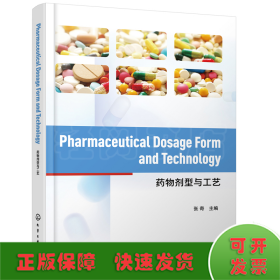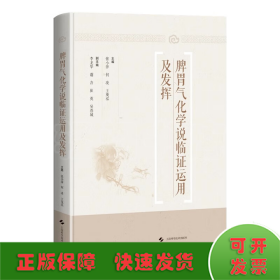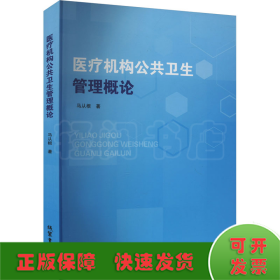
Pharmaceutical Dosage Form and Technology(药物剂型与工艺)
全新正版 假一赔十 可开发票
¥ 51.61 7.6折 ¥ 68 全新
库存3件
作者张奇 主编
出版社化学工业出版社
ISBN9787122380906
出版时间2021-04
装帧精装
开本16开
定价68元
货号1202317543
上书时间2024-05-10
- 最新上架
商品详情
- 品相描述:全新
- 商品描述
-
前言
《Pharmaceutical Dosage Form and Technology(药物剂型与工艺)》介绍了一些有代表性的药物剂型和药物载体系统,通过对药物剂型和药物载体系统的处方、制备工艺过程、科学原理和临床应用特点等的介绍,使读者初步了解药物制剂与工艺学的基本原理、剂型设计、处方筛选以及不同药物剂型的临床应用等知识。
本书英语语言准确、表达流畅、内容精炼、通俗易懂、贴合实际教学。另外,药物制剂领域中*、*前沿的研究成果在本书中也有介绍。
本书由北京理工大学化学与化工学院制药工程系张奇主编。内容包括10章:第1章是基础知识介绍(张奇编写);第2章和第3章是固体药物制剂,在这两章中,除了对固体制剂基本内容的介绍外,还对制粒工艺和包衣工艺进行了重点讲述(刘方,Kavil Patel,张奇编写);第4章和第5章分别是肺部用药系统和透皮药物运载系统,介绍了该领域的前沿工艺和技术(金义光,杜丽娜,李淼编写);第6章和第7章分别是液体制剂和无菌制剂,包括混悬液、乳剂、注射剂等剂型(杨子毅,林霞编写);第8章是口服载药系统和该领域的*研究成果(张宇编写);第9章是栓剂(张奇编写);第10章是有关儿童患者和老年患者临床用药注意事项(刘方编写)。
本书的编写人员由国内外高校药物制剂专业的一线专任教师和研究所的药物制剂科研工作人员组成,这些专家不仅在教学和科研工作中积累了丰富的经验和素材,而且能够敏锐捕捉和跟踪该领域*国际前沿,使本书内容有较强的实用性和新颖性。
本书获批北京理工大学2020年“特立”系列教材,并得到了北京理工大学教育经费的资助,在本书的编写过程中还得到了学校和学院领导的关心和支持,在此深表感谢。
编者们虽然在编写过程中尽了*努力,但书中还是难免有疏漏之处,诚恳希望广大读者在使用本书有所收获的同时,将体会和批评指正意见反馈给我们,使本书不断完善、修正和提高。
张奇
2020年6月
This is the first edition of Pharmaceutical Dosage Form and Technology.
The purpose of this book is to introduce some representative dosage forms and drug delivery systems, which include the definition, excipients, manufacturing process and scientific principle underlying the preparation of them.
This book can be used as textbook for pharmaceutical sciences undergraduate students. It can also be used as the reading book for pharmaceutical sciences/pharmacy related subject undergraduate students and pharmaceutical sciences graduate students.
This book consists of ten chapters. The first chapter is introduction of the basic knowledge of drug and pharmacy. The second chapter is an overview of solid dosage forms. The third chapter is focused on the granulation process and the fourth chapter is on film coating technology. The fifth chapter is pulmonary drug delivery systems and the sixth chapter is transdermal drug delivery system. Some frontier and advanced dosage forms and the technologies are shown in these two chapters. The seventh chapter introduces different liquid dosage forms such as suspension and emulsion. The eighth chapter is for the sterilized preparations. The chapter nine is about modified-release oral drug delivery including current advancement in this field. Chapter ten is regarding suppositories as drug delivery dosage forms. The eleventh chapter is the last chapter and focuses on considerations in dosage form application to the pediatric and geriatric patients.
The authors of this book consist of professors from different pharmaceutical universities with strong academic backgrounds.
I acknowledge with grateful appreciation to the writers of this book and especially thank to the funding from Beijing Institute of Technology, which support the publication of this book.
Nevertheless, some inaccuracy might occur in this book, which we will endeavor to improve and correct in the future. We hope that readers will find this book valuable and we appreciate your opinions during you using this book to continuously improve its quality and accuracy.
Qi Zhang
2020.06
【书摘与插画】
商品简介《Pharmaceutical Dosage Form and Technology(药物剂型与工艺)》通过介绍药物剂型和药物载体系统的处方、制备工艺过程、科学原理和临床应用特点等,使读者初步了解药物制剂与工艺的基本原理、剂型设计、处方筛选以及不同药物剂型的临床应用等知识,还可以对一些制剂的*、*前沿研究成果有所了解。本书共10章:第1章是基础知识介绍;第2章和第3章是固体药物制剂;第4章和第5章分别是肺部用药系统和透皮药物运载系统;第6章和第7章分别是液体制剂和无菌制剂;第8章是口服载药系统和该领域的*研究成果;第9章是栓剂;第10章是有关儿童患者和老年患者临床用药注意事项。本书内容精炼、通俗易懂、英语语法准确,贴合实际教学需求,有助于提高学生专业英语水平。
本书可以作为药学类专业本科生或研究生药物制剂与工艺学及相关课程的教材,也可以作为药学相关领域科研人员的参考书。
目录Chapter 1 Introduction 1
1.1 Drugs and diseases 1
1.1.1 Treatment of diseases 1
1.1.2 Drug substances and medicines 1
1.1.3 The history of drugs 2
1.1.4 The drug-target interaction 3
1.2 About pharmacy 5
1.2.1 Pharmaceutical sciences 5
1.2.2 Pharmaceutics 5
1.2.3 Dosage forms and drug delivery systems 6
1.2.4 Categories of DDS 9
1.3 The standardization of medicine 11
1.3.1 Why medicine needs standard 11
1.3.2 Pharmacopeia 12
1.4 Clinical using medicine 12
1.4.1 Brand medicine and generic medicine 12
1.4.2 Prescription medicine and over-the-counter medicine 13
1.4.3 Prescription 13
1.4.4 Drug-drug interaction 14
1.4.5 Drug-food interaction 14
References 16
Chapter 2 Solid dosage forms I 17
2.1 Introduction 17
2.2 Powder 18
2.3 Granules 20
2.3.1 Preparation of granules 22
2.3.2 Granulation methods and equipments 22
2.3.3 Quality control of granules 31
References 33
Chapter 3 Solid dosage forms II 34
3.1 Capsules 34
3.1.1 Hard gelatin capsules 34
3.1.2 Soft capsules 36
3.2 Tablets 37
3.2.1 Excipients of tablets 39
3.2.2 Manufacture of tablets 40
3.2.3 Film coating 42
3.2.4 Quality control of tablets 53
3.2.5 Packaging and storing of tablets 58
References 59
Chapter 4 Pulmonary drug delivery system 60
4.1 Introduction 60
4.1.1 Anatomy of lungs 60
4.1.2 Advantages of pulmonary drug delivery 61
4.1.3 Mechanisms of particle deposition in the lung 62
4.2 Pulmonary drug delivery devices 62
4.2.1 Nebulizers 63
4.2.2 pMDIs 64
4.2.3 DPIs 64
4.2.4 Soft mist inhaler 65
4.3 Factors governing aerosol deposition and targeting in the lung 66
4.3.1 Aerodynamic diameter and size distribution 66
4.3.2 Airflow rate 66
4.3.3 Particle shape 67
4.3.4 Particle density 67
4.3.5 Surface roughness 67
4.4 Clinical application of pulmonary drug delivery systems 68
4.5 Perspectives of pulmonary drug delivery 69
References 70
Chapter 5 Transdermal drug delivery system 73
5.1 Introduction 73
5.2 Skin structure and the major obstacles of transdermal permeation 74
5.3 Major transdermal routes 75
5.3.1 Appendageal routes 75
5.3.2 Transcellular routes 75
5.3.3 Intercellular routes 75
5.4 Chemical penetration enhancers 76
5.4.1 Natural chemical penetration enhancers 76
5.4.2 Synthetic chemical penetration enhancers 77
5.4.3 Combination of penetration enhancers 82
5.5 Physical techniques to improve transdermal delivery 83
5.5.1 Microneedle 83
5.5.2 Laser 84
5.5.3 Iontophoresis 86
5.5.4 Sonophoresis 87
5.5.5 Electroporation 89
5.5.6 Magnetophoresis 90
5.5.7 Microwave 90
5.6 Transdermal formulations 91
5.6.1 Liposome 91
5.6.2 Cubic phase 91
5.6.3 Microemulsion 91
5.6.4 Hydrogel 91
5.6.5 Transfersome 92
5.7 Device-assisted or wearable transdermal delivery systems 92
5.7.1 Development stages 92
5.7.2 Device 93
5.7.3 Application 94
5.7.4 Prospect 94
References 94
Chapter 6 Liquid dosage forms 101
6.1 Introductions 101
6.1.1 Solubilities 101
6.1.2 Solvents 102
6.1.3 Enhancements 103
6.2 Syrups 103
6.3 Elixirs 104
6.4 Suspensions 105
6.4.1 Sedimentation of particles in suspension 105
6.4.2 Preparation of suspensions 107
6.4.3 Colloidal dispersions 108
6.5 Emulsions 109
6.5.1 Pharmaceutical emulsions 110
6.5.2 Emulsion formation theory 111
6.5.3 Emulsion identification 112
6.5.4 Emulsion preparation 112
6.5.5 The HLB system 116
6.5.6 Emulsion stability 117
6.5.7 Nanoemulsions 120
6.6 Creams 121
6.7 Gels and magmas 122
References 123
Chapter 7 Sterilized preparations 124
7.1 Principles of sterilization 124
7.1.1 Introduction 124
7.1.2 Sterilization parameters 124
7.1.3 Principles of sterilization processes 125
7.1.4 Gaseous sterilization 127
7.1.5 Radiation sterilization 128
7.1.6 Filtration sterilization 129
7.1.7 High-level disinfection 129
7.2 Parenteral 130
7.2.1 Introduction 130
7.2.2 Injections 130
7.2.3 Large-volume parenterals 131
7.3 Biologics 131
7.3.1 Introduction 131
7.3.2 Types of immunity 132
7.3.3 Production of biologics 132
7.4 Ophthalmic solution and suspensions 133
7.4.1 Introduction 133
7.4.2 Pharmaceutical requirements 134
References 136
Chapter 8 Modified-release oral drug delivery 138
8.1 Introduction of modified-release oral drug delivery 138
8.1.1 Sustained-release preparation 138
8.1.2 Controlled-release preparation 138
8.1.3 Delayed-release preparation 138
8.2 Theories of extended-release oral drug delivery 139
8.2.1 Theory of dissolution-controlled 139
8.2.2 Theory of diffusion-controlled 140
8.2.3 Combination of erosion and diffusion theory 141
8.2.4 Osmotic pressure theory 142
8.2.5 Ion exchange theory 143
8.3 Design of extended-release oral drug delivery systems 144
8.3.1 Properties of drugs 144
8.3.2 Design requirements 147
8.4 Quality assessment 149
8.4.1 In vitro assessment 149
8.4.2 In vivo assessment 150
8.4.3 In vitro correlation 150
8.5 Application of extended-release oral drug delivery systems 154
8.6 Oral chronopharmacologic and oral site-specific drug delivery system 160
8.6.1 Overview 160
8.6.2 Theories 161
8.6.3 Brief introductions 163
8.6.4 Applications 166
References 171
Chapter 9 Suppositories 173
9.1 Introduction 173
9.2 Suppository bases 174
9.2.1 Fatty or oleaginous bases 174
9.2.2 Water-soluble or water-miscible bases 174
9.3 Preparation o
— 没有更多了 —















以下为对购买帮助不大的评价